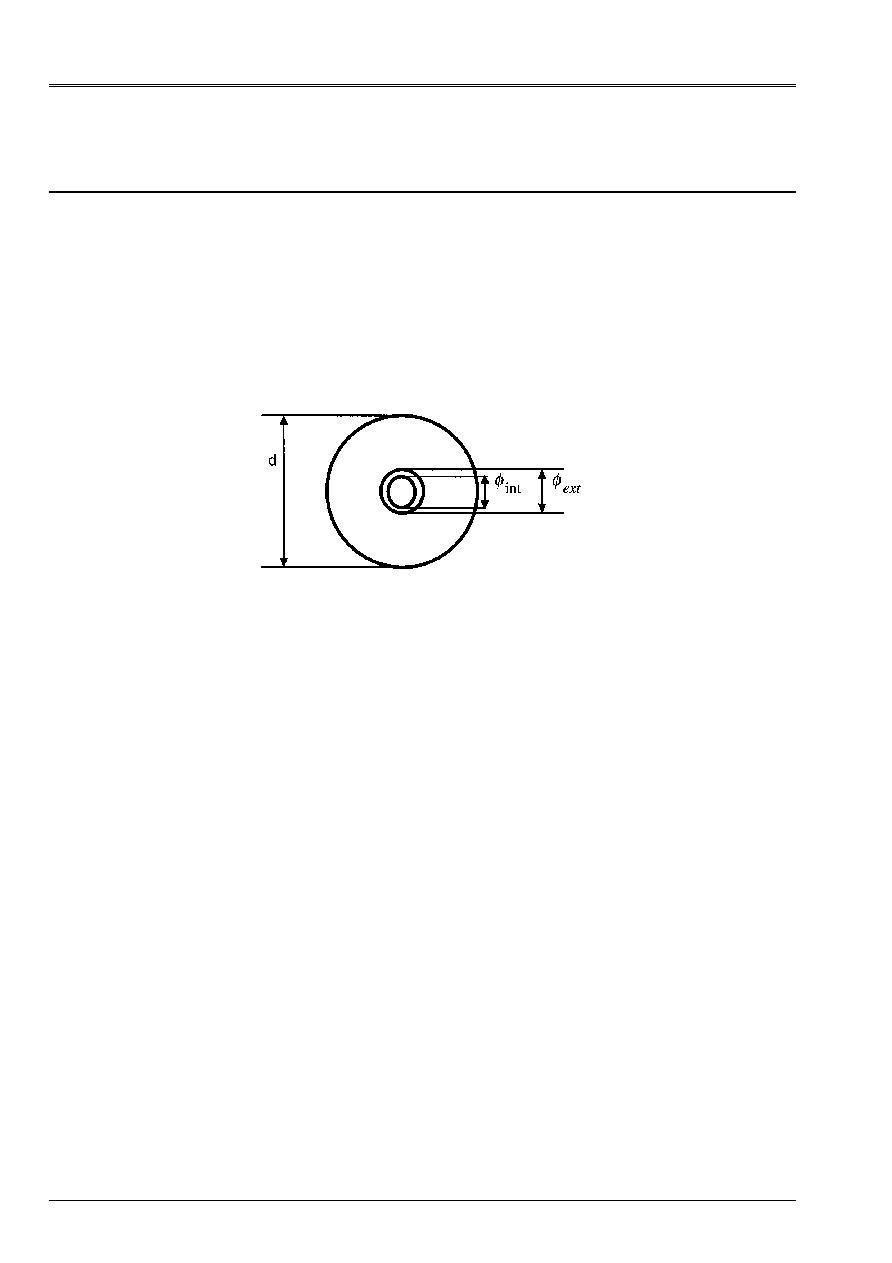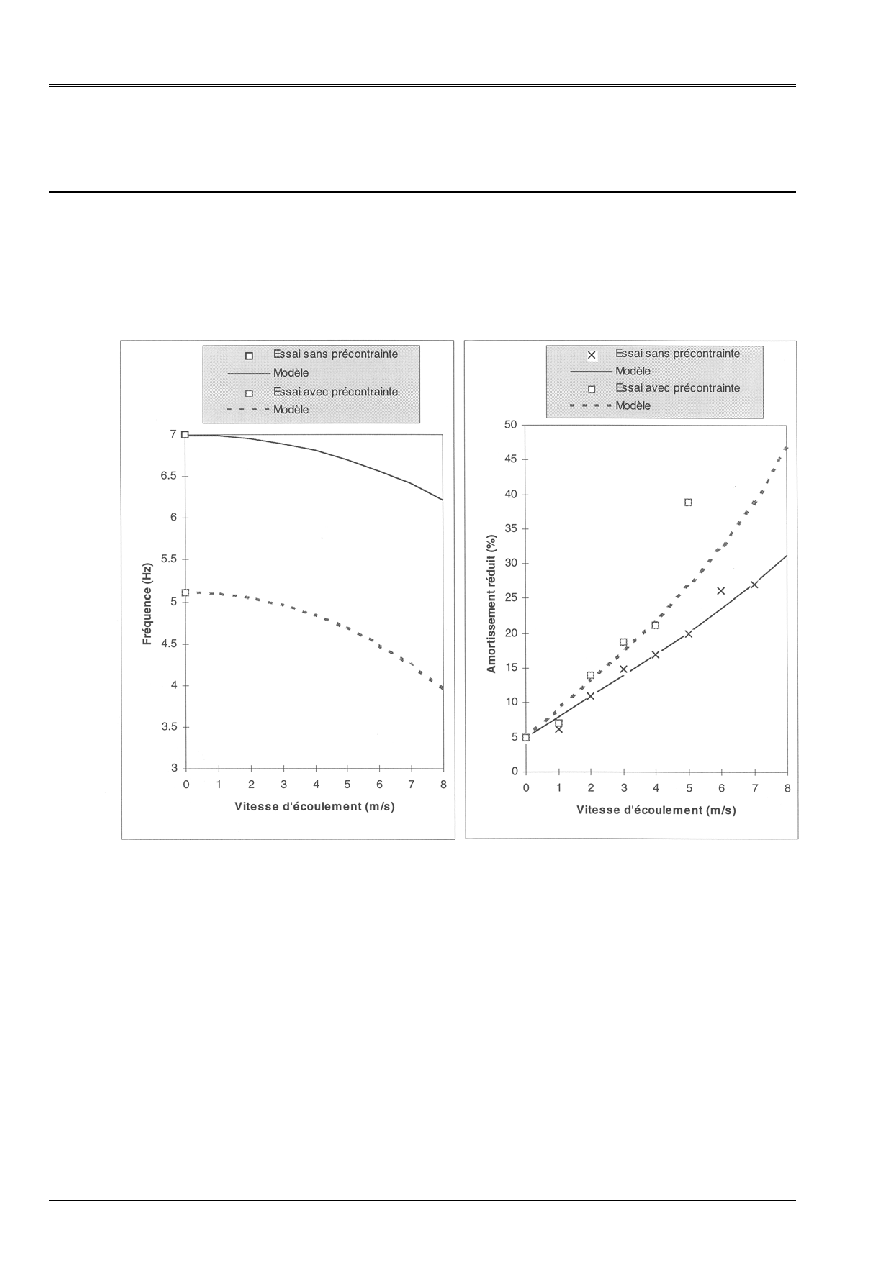
Code_Aster
®
Version
6.4
Titrate:
SDLL118 - Beam subjected to an axial excitation fluid-rubber band
Date:
01/03/04
Author (S):
A. ADOBES, Mr. LAINET
Key
:
V2.02.118-A
Page:
1/10
Manual of Validation
V2.02 booklet: Linear dynamics of the beams
HT-66/04/005/A
Organization (S):
EDF-R & D/MFTT, CS
Manual of Validation
V2.02 booklet: Linear dynamics of the beams
Document: V2.02.118
SDLL118 - Beam subjected to an excitation
fluid-rubber band axial
Summary:
One considers a PVC tube placed at the center of a cylindrical chamber of section circular and subjected to
the action of an axial water flow. This hardware configuration corresponds to the experimental device of
Tanaka and Al [bib1] which is used to measure the evolutions of frequency and reduced damping of the first mode
tube according to the mean velocity of the flow.
The goal of this case-test is to validate the resorption of the model
MEFISTEAU
[R4.07.04] allowing to calculate them
modal characteristics of a telegraphic structure under confined axial flow, by taking account of one
excitation of the fluid-rubber band type.
The functionalities particular to test are as follows:
·
operator
DEFI_FLUI_STRU
[U4.25.01]: definition of the parameters for the taking into account of
coupling fluid-rubber band, in the case of a configuration of the type “beam of tubes under
axial flow “(key word factor
FAISCEAU_AXIAL
),
·
operator
CALC_FLUI_STRU
[U47.66.02]: calculation of the evolutions of the frequencies and depreciation
modal tiny rooms according to the mean velocity of the flow, by the implementation of the model
MEFISTEAU
.
The numerical results of the simulation of the device of Tanaka and Al are validated by comparison with
experimental results. Taking into account relatively important uncertainties on the values
experimental, the results of reference for nonthe regression of the code are those obtained numerically
during the restitution of the case-test.

Code_Aster
®
Version
6.4
Titrate:
SDLL118 - Beam subjected to an axial excitation fluid-rubber band
Date:
01/03/04
Author (S):
A. ADOBES, Mr. LAINET
Key
:
V2.02.118-A
Page:
2/10
Manual of Validation
V2.02 booklet: Linear dynamics of the beams
HT-66/04/005/A
1
Problem of reference
1.1 Geometry
The tube considered is a hollow roll whose characteristic dimensions are as follows:
length
L
= 1 m,
external diameter
ext.
= 13 mm,
internal diameter
int
= 8,8 Misters.
The tube is placed in the center of a cylindrical chamber of circular section. The internal diameter of
the chamber is worth D = 5 cm.
The surface roughness of the tube is worth
= 10
5
Mr.
1.2
Properties of materials
The physical characteristics of material PVC constituting the tube are as follows:
Young modulus
E = 2,80. 10
9
AP,
Poisson's ratio
= 0,3,
density
= 1500 kg/m
3
.
Water surrounding the tube has the following properties:
density
water
= 1000 kg/m
3
,
kinematic viscosity
water
= 1,1.10
6
m
2
/S.
1.3
Boundary conditions and loadings
The two ends of the tube are connected to fixed supports by two metal stems. The relative one
flexibility of bending of these stems releases the degrees of freedom of rotation of the ends of the tube. One
can thus estimate that the conditions of self-supporting quality of the tube are of the ball joint-ball joint type, the stems
metal introducing of each end an additional stiffness of rotation.
Moreover, these stems make it possible to apply an axial load to the tube, which can thus be prestressed in
traction or in compression. In practice, two configurations are studied:
·
nonprestressed tube: no effort is applied. This configuration corresponds to
modeling A of the case-test,
·
tube prestressed in compression by application of an axial load of 40 NR at an end.
This configuration corresponds to modeling B of the case-test.

Code_Aster
®
Version
6.4
Titrate:
SDLL118 - Beam subjected to an axial excitation fluid-rubber band
Date:
01/03/04
Author (S):
A. ADOBES, Mr. LAINET
Key
:
V2.02.118-A
Page:
3/10
Manual of Validation
V2.02 booklet: Linear dynamics of the beams
HT-66/04/005/A
1.4 Reference
bibliographical
[1]
Mr. TANAKA, K. FUJITA, A. HOTTA and NR. KONO: “Parallel flow-induced damping off PWR
fuel assembly ", ASME Conference, Pittsburgh, AP, PVP vol. 133 (1988)

Code_Aster
®
Version
6.4
Titrate:
SDLL118 - Beam subjected to an axial excitation fluid-rubber band
Date:
01/03/04
Author (S):
A. ADOBES, Mr. LAINET
Key
:
V2.02.118-A
Page:
4/10
Manual of Validation
V2.02 booklet: Linear dynamics of the beams
HT-66/04/005/A
2
Reference solution
The experimental measurements taken on the device of Tanaka and Al provide the values of
reference for the validation of the model.
Two graphs below, representing the evolutions of the frequencies and damping
tiny room of the first mode doubles bending according to the mean velocity of the flow,
allow to compare the results of the model with the experimental results.
Taking into account uncertainties on the measurements, the tolerance of relative variation for the validation of the model
is rather broad. This is why the experimental measurements cannot be used as values of reference
for the case-test, a narrower tolerance being necessary to guarantee nonthe regression of the code.
values of reference used are thus those obtained numerically during the restitution of the case
test.

Code_Aster
®
Version
6.4
Titrate:
SDLL118 - Beam subjected to an axial excitation fluid-rubber band
Date:
01/03/04
Author (S):
A. ADOBES, Mr. LAINET
Key
:
V2.02.118-A
Page:
5/10
Manual of Validation
V2.02 booklet: Linear dynamics of the beams
HT-66/04/005/A
3 Modeling
With
3.1
Characteristics of modeling
The tube is represented by 100 elements of right beams of Timoshenko (
MECA_POU_D_T
),
supported per as many meshs segments to 2 nodes (
SEG2
). Two elements
MECA_DIS_TR
are
additions with the nodes ends of the tube, allowing to modelize the metal stems by stiffnesses
of rotation discrete.
One carries out with the elements of beam the characteristics of circular section:
external radius
Rext = 6,5.10
3
m,
thickness E
=
2,1.10
3
Mr.
(cf paragraph [§1.1])
One also assigns to these elements a material of behavior
ELAS
:
Young modulus
E = 2,80. 10
9
AP,
Poisson's ratio
= 0,3,
density
= 1500 kg/m
3
.
(cf paragraph [§1.2])
One assigns to the discrete elements the same stiffness of rotation around the two orthogonal axes to
the neutral fiber of the tube:
K
R
= 6,29 Nm/rad
This stiffness of rotation was adjusted in order to find the Eigen frequency of the first double mode
in air.
The degrees of freedom in translation DX and DZ of the nodes ends N001 and N101 are locked so
to prohibit a rigid movement of body of the tube (axial translatory movement). One locks
also the DY of the N001 node. Moreover, in each node, one locks the degree of freedom of rotation
DRY, in order to prohibit any movement of torsion.
The tube is immersed in a cylindrical chamber of 2,5 cm interior radius (cf paragraph
[§1.1]). The profiles of density and kinematic viscosity of surrounding water are
presumedly constant along the tube:
density
water
= 1000 kg/m
3
,
kinematic viscosity
water
= 1,1.10
6
m
2
/S.
(cf paragraph [§1.2])
No axial load is applied to the tube which is thus not prestressed.
The evolutions of the frequency and the reduced damping of the first double mode of bending are
calculated for a range mean velocities of flow from 0 to 8 m/s, by pitch of 1 m/s.
One takes account of an initial reduced damping of the tube of the 4,8%.
3.2
Characteristics of the mesh
The total number of nodes used for the mesh is 101.
Meshs (of type
SEG2
) are 100.
The file of mesh is with the format
ASTER
.

Code_Aster
®
Version
6.4
Titrate:
SDLL118 - Beam subjected to an axial excitation fluid-rubber band
Date:
01/03/04
Author (S):
A. ADOBES, Mr. LAINET
Key
:
V2.02.118-A
Page:
6/10
Manual of Validation
V2.02 booklet: Linear dynamics of the beams
HT-66/04/005/A
3.3
Stages of calculation
Validation of the operators of coupling fluid-structure, for configurations of the type “beam
tubes under axial flow “is made in two main stages.
The first consists in defining the parameters of taking into account of the coupling fluid-structure with
the operator
DEFI_FLUI_STRU
follow-up of the key word
FAISCEAU_AXIAL
.
The second is the calculation of the evolutions of modal frequency and reduced damping according to
mean velocity of the flow, with the operator
CALC_FLUI_STRU
and by the implementation of
model
MEFISTEAU
.
3.4 Functionalities
tested
Controls Key word
factor Key word
DEFI_FLUI_STRU
FAISCEAU_AXIAL
TYPE_PAS: “CARRE_LIGN”
NOT: 1.5
TYPE_RESEAU: 1/3
CALC_FLUI_STRU BASE_MODALE
MODE_MECA
MODI_BASE_MODALE

Code_Aster
®
Version
6.4
Titrate:
SDLL118 - Beam subjected to an axial excitation fluid-rubber band
Date:
01/03/04
Author (S):
A. ADOBES, Mr. LAINET
Key
:
V2.02.118-A
Page:
7/10
Manual of Validation
V2.02 booklet: Linear dynamics of the beams
HT-66/04/005/A
4
Results of modeling A
4.1 Values
tested
The tests relate to the frequency and the reduced damping of the first double mode of bending of
tube, at the mean velocity of flow of 0 m/s and 4 m/s. 2 types of test are carried out:
·
a test of comparison with the experimental measurements,
·
a test to guarantee nonthe regression of the code.
4.1.1 Frequency of the first mode doubles bending
·
Test of comparison with the experiment, at the rate of flow of 0 m/s:
The tolerance of relative variation compared to the experimental value is worth 0,1%.
Number of the mode
Experimental value
Computed value
Relative variation
1
7 Hz
7,0011331924304 Hz
+0,016%
2
7 Hz
7,0011331924505 Hz
+0,016%
·
Test of nonregression of the code, at the rate of flow of 4 m/s:
The tolerance of relative variation compared to the reference is worth 10
8
%.
Number of the mode
Value of reference
Computed value
Relative variation
1
6,812275 Hz
6,8122749601350 Hz
5,85.10
9
%
2
6,812275 Hz
6,8122749601557 Hz
5,85.10
9
%
4.1.2 Reduced damping of the first mode doubles bending
·
Test of comparison with the experiment, at the rate of flow of 4 m/s:
The tolerance of relative variation compared to the reference is worth 1%.
Number of the mode
Experimental value
Computed value
Relative variation
1
17%
16,972486655473%
0,162%
2
17%
16,972486655445%
0,162%
·
Test of nonregression of the code, at the rate of flow of 4 m/s:
The tolerance of relative variation compared to the reference is worth 10
6
%.
Number of the mode
Value of reference
Computed value
Relative variation
1
16,97249%
16,972486655473%
1,97.10
7
%
2
16,97249%
16,972486655445%
1,97.10
7
%
4.2 Remarks
The values of reference those are obtained by Code_Aster during the restitution of the case-test, which
thus allows to check nonthe regression of the code during its evolution.

Code_Aster
®
Version
6.4
Titrate:
SDLL118 - Beam subjected to an axial excitation fluid-rubber band
Date:
01/03/04
Author (S):
A. ADOBES, Mr. LAINET
Key
:
V2.02.118-A
Page:
8/10
Manual of Validation
V2.02 booklet: Linear dynamics of the beams
HT-66/04/005/A
5 Modeling
B
5.1
Characteristics of modeling
Modeling B is identical to modeling A (cf paragraph [§3.1]), but this time the tube is
prestressed in compression.
An axial load of compression of 23,7 NR is applied to the node N101 end. The intensity of the effort has
thus readjusted compared to the provided experimental value of 40 NR, in order to find
correctly the value of frequency of the first mode doubles in air (cf paragraphs [§1.2], [§1.3]). It
readjustment can apply by the summary modeling of the metal stems ensuring it
self-supporting quality and the setting in compression.
One deduces from the nodal effort the vector of elementary efforts, then an assembled vector which is built
according to the classification of the degrees of freedom of the tube. Static deformation due to the setting in
compression is then obtained by multiplying the vector assembled by the reverse of the matrix of rigidity
structural. Using this static deformation, one calculates then a stress field with
elements, whose is deduced a geometrical matrix of rigidity. The aforementioned is then added to
stamp structural rigidity in order to obtain the matrix of rigidity of the tube in compression, which is
finally used for the calculation of the modes in air.
The evolutions of the frequency and the reduced damping of the first double mode of bending are
calculated for a range mean velocities of flow from 0 to 8 m/s, by pitch of 1 m/s. One holds
count of an initial reduced damping of the tube of 4,3%.
5.2
Characteristics of the mesh
The characteristics of the mesh of this second modeling are the same ones as those of
modeling A, is:
101 nodes used and 100 meshs of the type
SEG2
.
The file of mesh is with the format
ASTER
.
5.3
Stages of calculation
Just as for modeling A, the functionalities to be validated are those of the operators of
coupling fluid-structure for configurations of the type “beam of tubes under axial flow”
(cf paragraph [§3.3]).
Moreover, modeling B makes it possible to test other functionalities.
The first makes it possible to carry out the calculation of a field of displacements to the nodes by inversion of
stamp rigidity structural and product of the reverse by a vector of assembled effort, with
operators
FACT_LDLT
and
RESO_LDLT
.
The second allows the calculation of a geometrical matrix of rigidity using a stress field
with the elements, with the operator
CALC_MATR_ELEM
, option
RIGI_GEOM
.
5.4 Functionalities
tested
Controls Key word
factor Key word
FACT_LDLT
RESO_LDLT
CALC_MATR_ELEM RIGI_GEOM
DEFI_FONC_FLUI
DEFI_FLUI_STRU FAISCEAU_AXIAL
DEFI_MATERIAU ELAS_FLUI
CALC_FLUI_STRU BASE_MODALE
MODE_MECA
MODI_BASE_MODALE

Code_Aster
®
Version
6.4
Titrate:
SDLL118 - Beam subjected to an axial excitation fluid-rubber band
Date:
01/03/04
Author (S):
A. ADOBES, Mr. LAINET
Key
:
V2.02.118-A
Page:
9/10
Manual of Validation
V2.02 booklet: Linear dynamics of the beams
HT-66/04/005/A
6
Results of modeling B
6.1 Values
tested
The tests relate to the frequency and the reduced damping of the first double mode of bending of
tube, at the mean velocity of flow of 0 m/s and 4 m/s. 2 types of test are carried out:
·
a test of comparison with the experimental measurements,
·
a test to guarantee nonthe regression of the code.
6.1.1 Frequency of the first mode doubles bending
·
Test of comparison with the experiment, at the rate of flow of 0 m/s:
The tolerance of relative variation compared to the reference is worth 0,1%.
Number of the mode
Experimental value
Computed value
Relative variation
1
5,1 Hz
5,1046169521712 Hz
+0,091%
2
5,1 Hz
5,1046169521914 Hz
+0,091%
·
Test of nonregression of the code, at the rate of flow of 4 m/s:
The tolerance of relative variation compared to the reference is worth 10
7
%.
Number of the mode
Value of reference
Computed value
Relative variation
1
4,842109 Hz
4,8421086446841 Hz
7,34.10
8
%
2
4,842109 Hz
4,8421086447056 Hz
7,34.10
8
%
6.1.2 Reduced damping of the first mode doubles bending
·
Test of comparison with the experiment, at the rate of flow of 4 m/s:
The tolerance of relative variation compared to the reference is worth 10%.
Number of the mode
Experimental value
Computed value
Relative variation
1
21,1%
21,935720674426%
+ 3,96%
2
21,1%
21,935720674292%
+ 3,96%
·
Test of nonregression of the code, at the rate of flow of 4 m/s:
The tolerance of relative variation compared to the reference is worth 10
7
%.
Number of the mode
Value of reference
Computed value
Relative variation
1
21,93572%
21,935720674426%
+3,07.10
8
%
2
21,93572%
21,935720674292%
+3,07.10
8
%
6.2 Remarks
The values of reference those are obtained by Code_Aster during the restitution of the case-test, which
allows to check nonthe regression of the code during its evolution.

Code_Aster
®
Version
6.4
Titrate:
SDLL118 - Beam subjected to an axial excitation fluid-rubber band
Date:
01/03/04
Author (S):
A. ADOBES, Mr. LAINET
Key
:
V2.02.118-A
Page:
10/10
Manual of Validation
V2.02 booklet: Linear dynamics of the beams
HT-66/04/005/A
Intentionally white left page.









